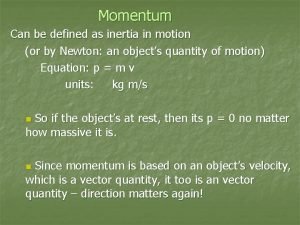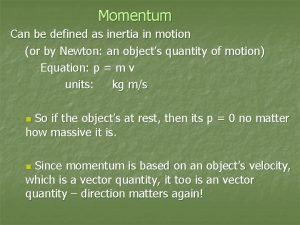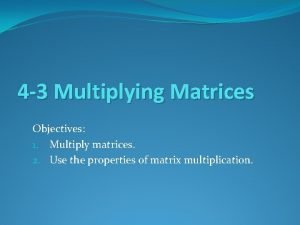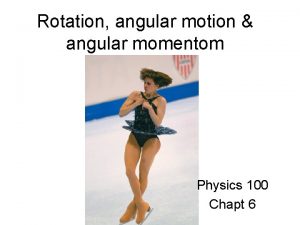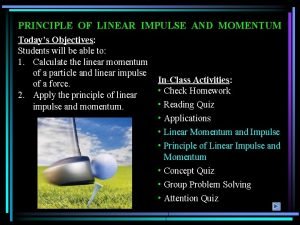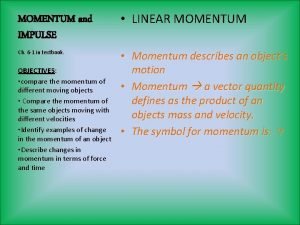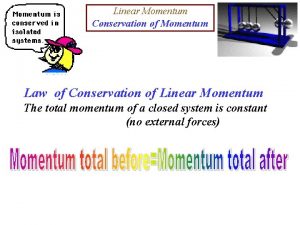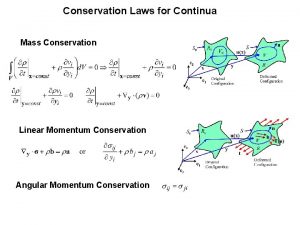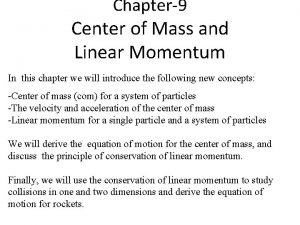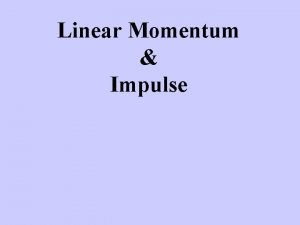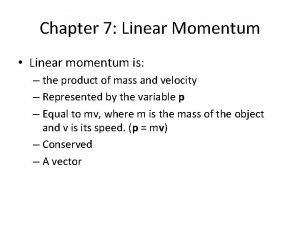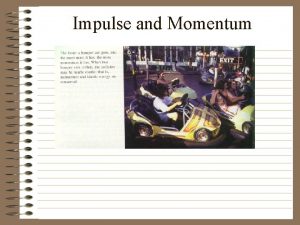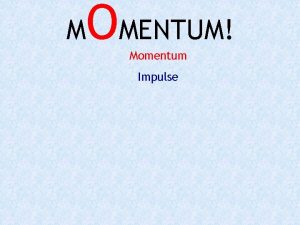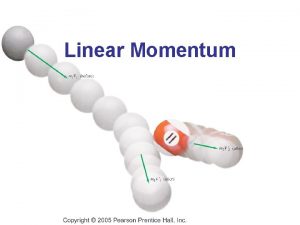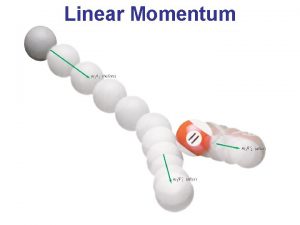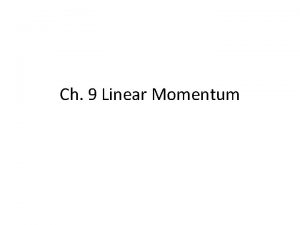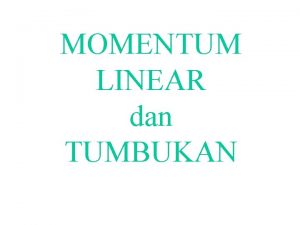Momentum Linear Momentum is defined as the product
















- Slides: 16

Momentum

Linear Momentum is defined as the product of mass and velocity. p=mv A vector quantity since velocity is a vector. The direction of momentum is the same as that of velocity, and the magnitude will be equal to the product mv. A critical feature of momentum is that oppositely directed momenta cancel out.

If a train is moving east at 20 km/hr and you run west on the train at 20 km/hr, you will fall straight down off the train when you get to the back. n When two objects collide, there are two principles which must be considered. The total momentum must be conserved n The objects act with impulsive, short lived, forces. n

n n A 0. 149 kg baseball traveling south at 28 m/s is hit and momentarily crushed ; it springs back, sailing away at 46 m/s due north. Find the magnitudes of the ball’s initial and final momenta and the change in momentum of the ball. (North positive) 0. 149 kg (-28 m/s) = -4. 2 kg m/s 0. 149 kg (46 m/s) = +6. 9 kg m/s Δp = p f – p o = +6. 9 – (-4. 2) = + 11. 1 kg m/s

Impulse n When a force acts on an object, we expect a proportional change in its motion. We studied this earlier with F= ma. That particular aspect of Newton’s 2 nd Law really comes from the more accurate statement of Newton’s 2 nd Law: n Fav = Δp Δt

Over a finite time interval Δt, the average net force equals the time rate of change in momentum. n A rocket fires its engine, producing an average of 1000 N of thrust, for 40 s. What is the resulting change in the rocket’s momentum? FavΔt=Δp = (1000 N )(40 s)= 40000 N • s For many collisions, neither Fav or time is known very well, but change in momentum is easily determined. n

We often then combine Fav and t into one quantity, impulse, that will equal the known change in momentum. n Impulse = change in momentum FavΔt = Δp A given impulse will produce a specific change in momentum no matter what the mass or speed of the recipient body. n

n n In order to determine the mass of a space station, a space ship of mass 3400 kg was docked to the station and then the engine was fired yielding an average force of 890 N for 7. 0 s. The station/ship underwent an increase in velocity of 0. 93 m/s. Determine the mass of the space station. (Fav )(t) = Δmv = mΔv = (msta + mship)Δv (890 N)(7. 0 s) = (x + 3400 kg)(0. 93 m/s) x = [(890)(7)/ 0. 93] – 3400 = 3300 kg

Force vs time graph n As shorter intervals of time are taken, the instantaneous force becomes average force, and area under curve is equal to net impulse, which can be set equal to change in momentum.

n Area above curve is positive impulse and below is negative, so subtracting these two areas will yield net impulse and thus the change in momentum.

Conservation of Momentum in One Dimension n Provided no external force acts on a system, the total momentum of the system must remain unchanged. A collision is marked by the transfer of momentum between objects in relative motion with each other during their interaction. In all cases where there are no external forces, the total momentum of the colliding objects must be conserved.

n n An inelastic collision is one where the final amount of KE in the system is less than the initial amount of KE. A tennis ball distorts and warms up, rebounding with less KE than it impacted with. The completely inelastic collision is where the two objects remain stuck together after the collision. Momentum will be conserved, but KE will not. Some of the energy goes into the deformation of the objects.

n n n An 842 N QB is standing still when he is tackled by a 1281 N lineman moving at 6. 1 m/s. What is the speed of the two players immediately after the collision? How much mechanical energy is lost during the collision? 0 + (130. 7)(6. 1) = (87. 1 kg + 130. 7 kg)Vf Vf = 3. 66 m/s KE init = ½ 130. 7 (6. 1 m/s)2 = 2. 43 k. J KE fin = ½ (87. 1 + 130. 7) (3. 66)2 = 1. 43 k. J About 1000 J is lost mostly to heat.

The other extreme case is the elastic collision where two objects collide and separate. Momentum and Kinetic energy are both conserved. n Both of the following will apply: m 1 v 1 i + m 2 v 2 i = m 1 v 1 f + m 2 v 2 f - in both cases n ½ m 1 v 1 i 2 + ½ m 2 v 2 i 2 = ½ m 1 v 1 f 2 + ½ m 2 v 2 f 2 Applies in the elastic collision only. n

n n Ex: An SUV with mass 1800 kg is traveling East 15. 0 m/s while a compact car with mass 900 kg is traveling W at -15 m/s. The cars collide head-on, becoming entangled. Find: a) Speed of cars after collision b) Change in velocity of each car c) Change in kinetic energy of the system.

m 1 v 1 i + m 2 v 2 i = m 1 v 1 f + m 2 v 2 f n m 1 v 1 i + m 2 v 2 i = vf (m 1 + m 2) (1800 kg )(15 m/s) + (900 kg)(-15 m/s) = vf (1800 + 900) = 5. 00 m/s Δv 1 = 5. 00 m/s – 15. 0 m/s = - 10 m/s Δv 2 = 5. 00 m/s – (-15. 0 m/s) = 20. 0 m/s KEi = (900 kg)(15 m/s)2 + (450 kg)(-15 m/s)2 = 3. 04 x 105 J KEf = (1350 kg)(5. 0 m/s)2 = 3. 38 x 104 J ΔKE = 3. 38 x 104 J – 3. 04 x 105 J = -2. 70 x 105 J n
 How to find maximum compression of a spring formula
How to find maximum compression of a spring formula A collection of well-defined objects.
A collection of well-defined objects. Momentum can be defined as
Momentum can be defined as Momentum can be defined as
Momentum can be defined as Determine whether each matrix product is defined
Determine whether each matrix product is defined Conceptual physics chapter 6 momentum
Conceptual physics chapter 6 momentum L
L Right hand rule physics angular momentum
Right hand rule physics angular momentum Principle of linear impulse and momentum
Principle of linear impulse and momentum A 2250 kg car traveling to the west slows down
A 2250 kg car traveling to the west slows down Law of conservation of linear momentum
Law of conservation of linear momentum Angular vs linear momentum
Angular vs linear momentum Center of mass and linear momentum
Center of mass and linear momentum Inelastic collision
Inelastic collision Define linear momentum.
Define linear momentum. Sebuah mobil mainan bermassa 4 kg
Sebuah mobil mainan bermassa 4 kg Calculate the impulse experienced when a 70kg person
Calculate the impulse experienced when a 70kg person


